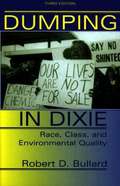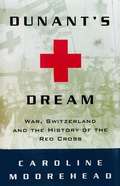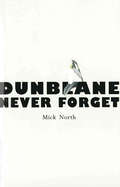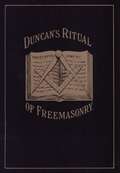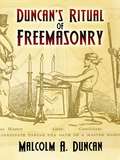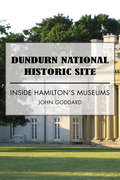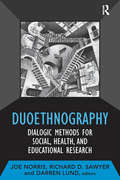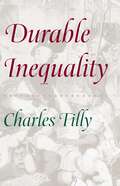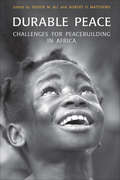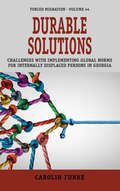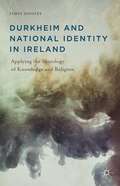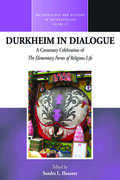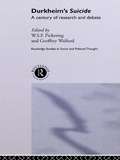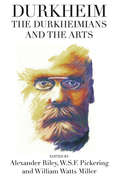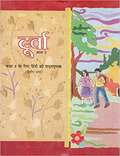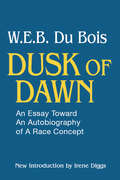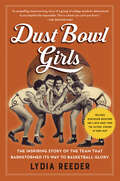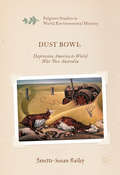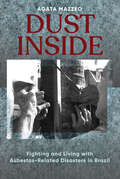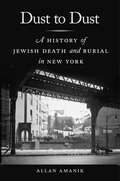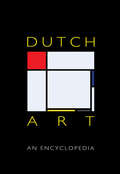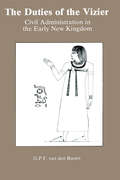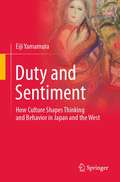- Table View
- List View
Dumping in Dixie: Race, Class, and Environmental Quality (3rd Edition)
by Robert D. BullardTo be poor, working-class, or a person of color in the United States often means bearing a disproportionate share of the country's environmental problems. Starting with the premise that all Americans have a basic right to live in a healthy environment, Dumping in Dixie chronicles the efforts of five African American communities, empowered by the civil rights movement, to link environmentalism with issues of social justice. In the third edition, Bullard speaks to us from the front lines of the environmental justice movement about new developments in environmental racism, different organizing strategies, and success stories in the struggle for environmental equity.
Dunant's Dream: War, Switzerland and the History of the Red Cross
by Caroline MooreheadThe Red Cross was the dream of the Swiss businessman Henri Dunant that grew into the preeminent international humanitarian charity. The story begins in 1859, when almost by chance, Dunant witnessed the butchery and lack of care for injured soldiers during the battle of Solferino. Realizing that, although modern warfare meant more, and worse, wounded, medical treatment for the first time could save significant numbers of them, he began a crusade leading to 137 national societies and 250 million members today. Caroline Moorehead, a popular columnist on human rights for the London Independent, is the first writer to be granted wide access to the Red Cross's closed archives in Geneva. Her resulting book engrossingly recounts the Red Cross's full history and the moral dilemmas it has faced from the two World Wars to the post-Cold War conflicts of Somalia, Chechnya, and Bosnia.
Dunblane: Never Forget
by Dr Mick NorthMick North's daughter Sophie was one of the children killed in the massacre at Dunblane Primary School. Dunblane: Never Forget is a personal account of Mick's life before and after the massacre and includes a critical assessement of the events that led to the tragedy and those that have followed. He begins by recalling his arrival in Stirling and how he and Barbara moved to Dunblane while awaiting the birth of their only child. A few months later Barbara was diagnosed with cancer and the family had to deal with her terminal illness. After the death of Barbara, father and daughter became an inseparable team until that dreadful day in 1996. North writes about how he and the other families dealt with public sympathy, the anti-handgun campaign, the memorial service, the television programmes, newspaper interviews and the creation of the Dunblane Memorial Garden. He describes how it felt to attend a public inquiry into the murder of his child, criticises the local police force and details the ambivalent attitude of the Dunblane community.
Duncan's Masonic Ritual and Monitor: Guide to the Three Symbolic Degrees of the Ancient York Rite and to the Degrees of Mark Master, Past Master, Most Excellent Master, and the Royal Arch
by Malcolm C. Duncan"The purpose of this work is not so much to gratify the curiosity of the uninitiated as to furnish a guide for the neophytes of the Order, by means of which their progress from grade to grade may be facilitated. Every statement in the book is authentic, as every proficient Mason will admit to himself, if not to be public, as he turns over its pages. The non-Masonic reader, as he peruses them, will perhaps be puzzled to imagine why matters of so little real importance to society at large should have been so industriously concealed for centuries, and still more surprised that society should have been so extremely inquisitive about them. "-From the Preface.
Duncan's Ritual of Freemasonry
by Malcolm A. DuncanThe fraternal society of the Masonic Order, steeped in mystery for over 600 years, is brought to light in a fascinating volume that serves as a guide for neophytes as well as a reference for the initiated. Duncan's Ritual of Freemasonry reveals the spiritual paths taken by inductees as they move through each initiated degree of enlightmentment: Mark Master, Past Master, Most Excellent Master, and the Royal Arch. The Freemasons' rituals, arcane symbols and mystical doctrines are also probed, and accurate explanations of gestures, tools and terms are accompanied by more than 100 illustrations and original engravings. The work is a fascinating exploration of the theories and practices of the world's most enduring secret society.
Dundurn National Historic Site: Inside Hamilton's Museums
by John GoddardInside Hamilton’s Museums helps to satisfy a growing curiosity about Canada’s steel capital as it evolves into a post-industrial city and cultural destination. In this special excerpt we visit Dundurn Castle, which once stood as the biggest house in British North America and reflected the outsized personality of its builder, Sir Allan Napier MacNab. Of Hamilton's museums, Dundurn Castle ranks as the biggest and most famous. The grounds host the Hamilton Military Museum, which specializes in the War of 1812. John Goddard takes us on a detailed tour of the historic home, providing fascinating historical background and insight.
Duoethnography: Dialogic Methods for Social, Health, and Educational Research (Developing Qualitative Inquiry #7)
by Joe Norris Richard D. Sawyer Darren E. LundDuoethnography is a collaborative research methodology in which two or more researchers juxtapose their life histories in order to provide multiple understandings of a social phenomenon. Using their own biographies as sites of research and creating dialogic narratives, they provide multiple perspectives of this phenomenon for the reader, inviting the viewer to enter the conversation. The dialectic process of creating duoethnography is also designed to be transformative to the writers. In this volume, two dozen scholars present the first wave of duoethnographic writings on topics as diverse as gender, identity, and curriculum, with the editors framing key tenets of the methodology around the studies presented. This participatory, emancipatory methodology is of interest to those doing qualitative research and narrative writing in many disciplines.
Durable Inequality
by Charles TillyCharles Tilly, in this eloquent manifesto, presents a powerful new approach to the study of persistent social inequality. How, he asks, do long-lasting, systematic inequalities in life chances arise, and how do they come to distinguish members of different socially defined categories of persons? Exploring representative paired and unequal categories, such as male/female, black/white, and citizen/noncitizen, Tilly argues that the basic causes of these and similar inequalities greatly resemble one another. In contrast to contemporary analyses that explain inequality case by case, this account is one of process. Categorical distinctions arise, Tilly says, because they offer a solution to pressing organizational problems. Whatever the "organization" is--as small as a household or as large as a government--the resulting relationship of inequality persists because parties on both sides of the categorical divide come to depend on that solution, despite its drawbacks. Tilly illustrates the social mechanisms that create and maintain paired and unequal categories with a rich variety of cases, mapping out fertile territories for future relational study of durable inequality.
Durable Peace: Challenges for Peacebuilding in Africa
by Robert Matthews Taisier AliThe African continent has been racked with war in the years since decolonization. In the aftermath of violent conflict, peace is often fragile. With Durable Peace, Taisier M. Ali and Robert O. Matthews have brought together leading scholars to discuss the experiences of ten African countries - Angola, Ethiopia, Liberia, Mozambique, Rwanda, Somalia, South Africa, Sudan, Uganda, and Zimbabwe - in recovering from violent civil war.In this series of remarkable and thought-provoking essays, the contributors shed light on the process of peacebuilding. Collectively, they demonstrate that if efforts to restore peace in war-torn societies are to be successful, such efforts must be wide in scope, involving security and political issues, as well as economic development and socio-psychological reconciliation. Additionally, they must be extended over long periods of time and, above all else, anchored in the local community.Peacebuilding is a difficult process, subject to frequent setbacks, and sometimes outright failure. Durable Peace concludes that any peacebuilding effort must include at least four building blocks: a secure environment, new political institutions that are broadly representative, a healthy economy, and a mechanism for dealing with injustices of the past and future. How these blocks are put together will vary, but if they are arranged to fit the specific local circumstances, the outcome will likely be self-sustaining peace.
Durable Solutions: Challenges with Implementing Global Norms for Internally Displaced Persons in Georgia (Forced Migration #44)
by Carolin FunkeFocusing on Georgia, this book presents a theoretical and empirical study on the implementation of durable solutions for internally displaced persons (IDPs). Building on extensive field research, it describes and explains the considerable problems which Georgia faces in establishing global norms, as well as the ongoing hardship that IDPs experience. Importantly, the book reveals the simultaneous progress and setbacks in implementing durable solutions. Successfully combining approaches from humanistic studies, international relations, and organizational sociology, this book explains the interaction of norms and actors at and among three societal levels: the international, national, and local.
Duress: Imperial Durabilities in Our Times
by Ann Laura StolerHow do colonial histories matter to the urgencies and conditions of our current world? How have those histories so often been rendered as leftovers, as "legacies" of a dead past rather than as active and violating forces in the world today? With precision and clarity, Ann Laura Stoler argues that recognizing "colonial presence" may have as much to do with how the connections between colonial histories and the present are expected to look as it does with how they are expected to be. In Duress, Stoler considers what methodological renovations might serve to write histories that yield neither to smooth continuities nor to abrupt epochal breaks. Capturing the uneven, recursive qualities of the visions and practices that imperial formations have animated, Stoler works through a set of conceptual and concrete reconsiderations that locate the political effects and practices that imperial projects produce: occluded histories, gradated sovereignties, affective security regimes, "new" racisms, bodily exposures, active debris, and carceral archipelagos of colony and camp that carve out the distribution of inequities and deep fault lines of duress today.
Durkheim and National Identity in Ireland
by James DingleyDurkheim and National Identity in Ireland uses the classical sociology of Durkheim, in association with established theories of nation formation, to explore the development of opposed national identities in Ireland and Northern Ireland. James Dingley looks at Catholicism, the core of Irish nationalist identity, and draws upon its established sociological association of pre-industrial, rural peasant society and culture. By contrast, Dingley reviews Protestantism as the core of Ulster identity, with the equal association of industrial, scientific society, as the key elements in explaining why Ulster Unionists evolved an opposed and incompatible culture and identity to Irish nationalism. These underlying religious philosophies of Catholicism and Protestantism illustrate how religion acted as a symbolic representation of socio-economic separate development, and examine a Durkheimian analysis as an alternative approach to conflict resolution in Northern Ireland.
Durkheim in Dialogue: A Centenary Celebration of The Elementary Forms of Religious Life
by Sondra L. HausnerOne hundred years after the publication of the great sociological treatise, The Elementary Forms of Religious Life, this new volume shows how aptly Durkheim¹s theories still resonate with the study of contemporary and historical religious societies. The volume applies the Durkheimian model to multiple cases, probing its resilience, wondering where it might be tweaked, and asking which aspects have best stood the test of time. A dialogue between theory and ethnography, this book shows how Durkheimian sociology has become a mainstay of social thought and theory, pointing to multiple ways in which Durkheim¹s work on religion remains relevant to our thinking about culture.
Durkheim's Suicide: A Century of Research and Debate (Routledge Studies in Social and Political Thought #Vol. 28)
by W.S.F. Pickering Geoffrey WalfordDurkeim's book on suicide, first published in 1897, is widely regarded as a classic text, and is essential reading for any student of Durkheim's thought and sociological method. This book examines the continuing importance of Durkheim's methodology. The wide-ranging chapters cover such issues as the use of statistics, explanation of suicide, anomie and religion and the morality of suicide. It will be of vital interest to any serious scholar of Durkheim's thought and to the sociologist looking for a fresh methodological perspective.
Durkheim, the Durkheimians, and the Arts
by W.S.F. Pickering Alexander Tristan Riley William Watts MillerUsing a broad definition of the Durkheimian tradition, this book offers the first systematic attempt to explore the Durkheimians' engagement with art. It focuses on both Durkheim and his contemporaries as well as later thinkers influenced by his work. The first five chapters consider Durkheim's own exploration of art; the remaining six look at other Durkheimian thinkers, including Marcel Mauss, Henri Hubert, Maurice Halbwachs, Claude Lévi-Strauss, Michel Leiris, and Georges Bataille. The contributors-scholars from a range of theoretical orientations and disciplinary perspectives-are known for having already produced significant contributions to the study of Durkheim. This book will interest not only scholars of Durkheim and his tradition but also those concerned with aesthetic theory and the sociology and history of art.
Durva Bhag-3 class 8 - NCERT - 23: दूर्वा भाग-३ ८वीं कक्षा - एनसीईआरटी - २३
by Rashtriy Shaikshik Anusandhan Aur Prashikshan Parishadकक्षा 8 के लिए हिंदी की पाठ्यपुस्तक, एन.सी.ई.आर.टी. इस पुस्तक की रचना के लिए बनाई गई पाठ्यपुस्तक निर्माण समिति के परिश्रम के लिए कृतज्ञता व्यक्त करती है। परिषद् भाषा सलाहकार समिति के अध्यक्ष प्रोफ़ेसर नामवर सिंह और इस पुस्तक के मुख्य सलाहकार प्रोफ़ेसर पुरुषोत्तम अग्रवाल की विशेष आभारी है। पाठ्यपुस्तक के विकास में कई शिक्षकों ने योगदान किया, इस योगदान को संभव बनाने के लिए परिषद् उनके प्राचार्यों एवं उन सभी संस्थाओं और संगठनों के प्रति कृतज्ञ है जिन्होंने अपने संसाधनों, सामग्री तथा सहयोगियों की मदद लेने में हमें उदारतापूर्वक सहयोग दिया। परिषद माध्यमिक एवं उच्च शिक्षा विभाग, मानव संसाधन विकास मंत्रालय द्वारा प्रोफ़ेसर मृणाल मीरी एवं प्रोफ़ेसर जी.पी. देशपांडे की अध्यक्षता में गठित निगरानी समिति (मॉनिटरिंग कमेटी) के सदस्यों को अपना मूल्यवान समय और सहयोग देने के लिए धन्यवाद देती है।
Dusk of Dawn!: An Essay Toward an Autobiography of Race Concept (The\library Of America)
by W. E. DuBoisIn her perceptive introduction to this edition, Irene Diggs sets this classic autobiography against its broad historical context and critically analyzes its theoretical and methodological significance.
Dust Bowl Girls: The Inspiring Story of the Team That Barnstormed Its Way to Basketball Glory
by Lydia Reeder“A thrilling, cinematic story. I loved every minute I spent with these bold, daring women whose remarkable journey is the stuff of American legend.” —Karen Abbott, New York Times bestselling author of Liar, Temptress, Soldier, Spy The Boys in the Boat meets A League of Their Own in this true story of a Depression-era championship women’s team. In the early 1930s, during the worst drought and financial depression in American history, Sam Babb began to dream. Like so many others, this charismatic Midwestern basketball coach wanted a reason to have hope. Traveling from farm to farm near the tiny Oklahoma college where he coached, Babb recruited talented, hardworking young women and offered them a chance at a better life: a free college education in exchange for playing on his basketball team, the Cardinals. Despite their fears of leaving home and the sacrifices that their families would face, the women joined the team. And as Babb coached the Cardinals, something extraordinary happened. These remarkable athletes found a passion for the game and a heartfelt loyalty to one another and their coach--and they began to win. Combining exhilarating sports writing and exceptional storytelling, Dust Bowl Girls takes readers on the Cardinals’ intense, improbable journey all the way to an epic showdown with the prevailing national champions, helmed by the legendary Babe Didrikson. Lydia Reeder captures a moment in history when female athletes faced intense scrutiny from influential figures in politics, education, and medicine who denounced women’s sports as unhealthy and unladylike. At a time when a struggling nation was hungry for inspiration, this unlikely group of trailblazers achieved much more than a championship season.
Dust Bowl: Depression America to World War Two Australia (Palgrave Studies in World Environmental History)
by Janette-Susan BaileyThis book takes the Dust Bowl story beyond Depression America to describe the ‘dust bowl’ concept as a transnational phenomenon, where during World War Two, US and Australian national mythologies converged. Dust Bowl begins with Depression America, the New Deal and the US Dust Bowl where massive dust storms darkened the skies of the Great Plains and triggered a major national and international media event and generated imagery describing a failed yeoman dream, Dust Bowl refugees, and the coming of a new American Desert. Dust Bowl traces the evolution of this imagery to Australia, World War Two and New Deal-inspired stories of conservation-mindedness, soil erosion and enemies, sheep-farmers and traitors, creeping deserts and human extinction, super-human housewives and natural disaster and finally, grand visions of a nation-building post-war scheme for Australia’s iconic Snowy River‒that vision became the Snowy Mountains Hydro-electric Scheme.
Dust Inside: Fighting and Living with Asbestos-Related Disasters in Brazil
by Agata MazzeoToxic production, disrupted lives and contaminated bodies. Care for unacknowledged suffering, incurable cancers, and immeasurable losses. This book bears witness to the invisible disasters provoked by the asbestos market worldwide and gives a voice to the communities of survivors who struggle daily in the name of social and environmental justice. Grounded in a profound, touching ethnography, this book offers an original contribution to understanding global health disasters and grassroots health-based activism.
Dust to Dust: A History of Jewish Death and Burial in New York (Goldstein-Goren Series in American Jewish History #7)
by Allan AmanikA revealing look at how death and burial practices influence the livingDust to Dust offers a three-hundred-year history of Jewish life in New York, literally from the ground up. Taking Jewish cemeteries as its subject matter, it follows the ways that Jewish New Yorkers have planned for death and burial from their earliest arrival in New Amsterdam to the twentieth century.Allan Amanik charts a remarkable reciprocity among Jewish funerary provisions and the workings of family and communal life, tracing how financial and family concerns in death came to equal earlier priorities rooted in tradition and communal cohesion. At the same time, he shows how shifting emphases in death gave average Jewish families the ability to advocate for greater protections and entitlements such as widows’ benefits and funeral insurance. Amanik ultimately concludes that planning for life’s end helps to shape social systems in ways that often go unrecognized.
Dutch Art: An Encyclopedia
by Sheila D. MullerAn illustrated feast for the eye and intellect Dutch Art explores developments in art, art history, art criticism, and cultural history of the Netherlands from the artists' workshops for the Utrecht Dom in 1475 to the latest movements of the 1990s. it is lavishly illustrated with 147 black-and-white photographs and 16 pages in full color. More than 100 internationally recognized scholars, museum professionals, artists, and art critics contributed signed essays to this monumental work, including historians, sociologists, and literary historians.
Duties Of The Vizier: Civil Administration in the Early New Kingdom
by G. P. Van Den BoornFirst Published in 1988. Routledge is an imprint of Taylor & Francis, an informa company.
Duty and Sentiment: How Culture Shapes Thinking and Behavior in Japan and the West
by Eiji YamamuraThis book is an exploration that shows us how sentiment and duty form the core of Japanese culture. It looks at how the combination of common sense, culture, and social norms influence people’s ways of thinking and behavior. Although the focus is Japan in looking at these interrelationships, the author draws on his experience and knowledge of other countries from his days before graduate school, when he traveled the world as a backpacker. Now, from the world of academia, he uses his knowledge of economic analysis to consider the similarities and differences in human behavior among countries and cultures. The wide-ranging scope of the book takes in marital life, education, sports, business, and culture in modern Japanese society. Why, for instance, does linguistic heterogeneity generally have negative effects on FIFA rankings of national soccer teams, and what does this have to do with the difficulty of technology transfer among businesses in multilingual countries? Why was the demand for the film Bohemian Rhapsody, about the British rock group Queen, so high in Japan? How do Kazuo Ishiguro’s novels resemble scenarios related to Japan’s long-term public finance prospects? How does the depiction of contemporary life compared with “the old days” in the films of Yasujiro Ozu provide a cautionary tale for aging societies today? How are older people with grandchildren more likely to accept tax increases to support future generations? And how is the Japanese government actively drawing on behavioral economics to appeal to public sentiment to contain the spread of COVID-19. These and a multitude of other questions are tackled by the backpacker who entered academia to become an economist and who now goes on a journey to find the answers. Readers can take the trip with him under his expert guidance, as he artfully combines sentiment, duty, and economic analysis.
Duty of Care for Learning Disability Workers
by Justine Barksby Lucy HarperIf you are working within the learning disability sector and studying for the QCF Diploma in Health and Social Care, you will find this book invaluable in helping you to achieve the unit on Duty of Care. It will help you to understand how duty of care affects the people you support, their family carers, you and your employer. The book is easy to navigate, with each chapter covering one of the learning outcomes within the unit. Each chapter begins with an example taken from real people's stories and lots of activities, photographs and other illustrations are included throughout.
